Transport On Land 2
- Lortu esteka
- Helbide elektronikoa
- Beste aplikazio batzuetan
Nowadays we travel long distances on land by car, bus and train. But for millions of years, prehistoric people walked.
We think that wheels were invented 5,000 years ago by the Mesopotamians. The wheels were made from solid wood. Animals pulled carts on wheels. A thousand years later, spokes were added which made the wheels much lighter.
The first vehicle to move by itself was the steam tractor, invented in 1769 by the Frenchman Nicolas Cugnot. The steam tractor worked by pumping pistons up and down to move the wheels. But the tractor was very heavy and unstable.
The first steam train was built in England in 1804 by Richard Trevithick and travelled at 8 kph. In 1829, George Stephenson and his son Robert won a competition to invent the fastest steam train. The Stephensons’ ‘Rocket’ could travel at 48 kph.
Transport on the road and rail was further advanced by the invention of the internal combustion engine in 1859.
The combustion engine worked by burning fuel inside cylinders and was much smaller and lighter than a steam engine. And in 1885 the German engineer Karl Benz built the first petrol-powered car.
These early hand-built cars were too expensive for ordinary people. But in 1908 Henry Ford started mass-producing cars in his factories. In the first 20 years of production, 15 million ‘Model T Ford’ cars were sold.
By the 1900s diesel engine trains (named after Rudolf Diesel, another German engineer) were also replacing steam trains.
Nowadays, cars and trains are often powered by diesel or petrol, but these fuels will run out. High-speed trains, such as the Japanese bullet train or the French TGV, which can travel over 300 kph now use electricity. Scientists are also experimenting with magnetic levitation trains and fuel cell cars (hydrogen) and solar powered cars.

We think that wheels were invented 5,000 years ago by the Mesopotamians. The wheels were made from solid wood. Animals pulled carts on wheels. A thousand years later, spokes were added which made the wheels much lighter.
The first vehicle to move by itself was the steam tractor, invented in 1769 by the Frenchman Nicolas Cugnot. The steam tractor worked by pumping pistons up and down to move the wheels. But the tractor was very heavy and unstable.
The first steam train was built in England in 1804 by Richard Trevithick and travelled at 8 kph. In 1829, George Stephenson and his son Robert won a competition to invent the fastest steam train. The Stephensons’ ‘Rocket’ could travel at 48 kph.
Transport on the road and rail was further advanced by the invention of the internal combustion engine in 1859.
The combustion engine worked by burning fuel inside cylinders and was much smaller and lighter than a steam engine. And in 1885 the German engineer Karl Benz built the first petrol-powered car.
These early hand-built cars were too expensive for ordinary people. But in 1908 Henry Ford started mass-producing cars in his factories. In the first 20 years of production, 15 million ‘Model T Ford’ cars were sold.
By the 1900s diesel engine trains (named after Rudolf Diesel, another German engineer) were also replacing steam trains.
Nowadays, cars and trains are often powered by diesel or petrol, but these fuels will run out. High-speed trains, such as the Japanese bullet train or the French TGV, which can travel over 300 kph now use electricity. Scientists are also experimenting with magnetic levitation trains and fuel cell cars (hydrogen) and solar powered cars.
- Lortu esteka
- Helbide elektronikoa
- Beste aplikazio batzuetan
